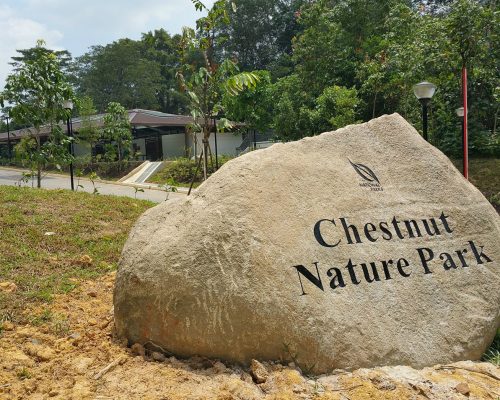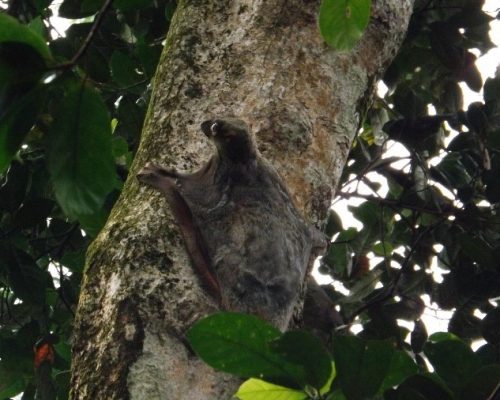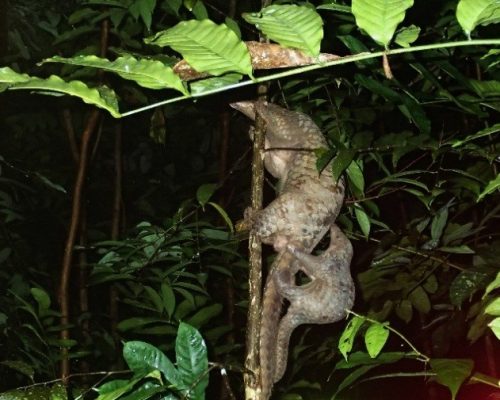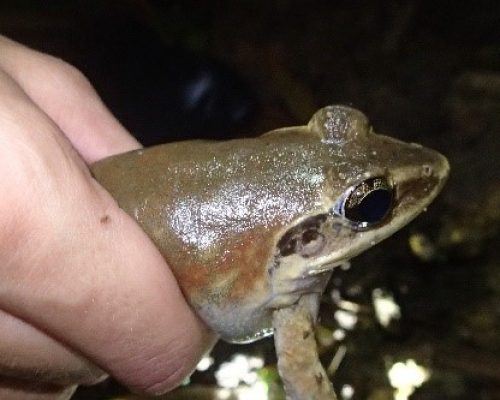

Sunda Colugo spotted during the biodiversity survey

A very rare Sunda Pangolin and its baby spotted in the wild: the population in Singapore is estimated to be less than 50. Pangolins give birth annually to only one or two offspring.

The Malayan Giant Frog – large adults can grow up to over 1 kg.
Overview
An Environmental Impact Assessment/Biodiversity Study was commissioned to evaluate the environmental impact of the proposed upgrading of a facility within Chestnut Avenue Waterworks (CAWW).
The CAWW is located on the western side of the Central Catchment Nature Reserve where it is bounded by Pierce Reservoir in the east and by secondary forests in the north, west, and south. These secondary forests are mature and primary forest remnants could be impacted by the upgrading works through edge effects or forest fragmentation. To safeguard the Reserve and forests, SECS was brought on to assess the current state of the environment and propose measures to mitigate any adverse impacts on environmentally sensitive areas.
The Central Catchment Nature Reserve
The Central Catchment Reserve is Singapore’s largest Nature Reserve, covering over 2,000 hectares and home to some of the richest forests in terms of biodiversity.
The forest here comprises mainly of dipterocarp – a family of hardwood, tropical trees that are recognized by their winged seeds. Dipterocarps are among the tallest trees in the world – a trait that has led to over-felling for timber, and has resulted in several species becoming endangered.
Key Facts
- Forest reserves make up 5% of Singapore’s land, but harbour over 50% of the native biodiversity.
- Many endangered and threatened species persist in Singapore’s forests, including the Sunda Pangolin (manis javanica) and the Blue-rumped Parrot (psittinus cyanurus).
Our Approach
To develop a holistic picture of the environment surrounding the CAWW, we conducted a battery of studies including:
- Biodiversity Impact Assessment
Field surveys for both flora and fauna were conducted. Observed species were categorized primarily by their national conservation status, and secondarily by their international conservation status.
Areas where species of conservational value were identified were then identified as “hotspots” and measured by proximity to the CAWW upgrading works.
- Tree Mapping and Inventory
Trees that could be affected during construction were identified by a certified arborist before being mapped out and categorized.
- Water Quality Study
Both in-situ and ex-situ water quality studies were conducted on the streams within the Reserve. The water was also tested for heavy metals and other potential contaminants.
- Sediment Quality Study
A sediment quality study was conducted to identify the baseline sediment conditions of the soil near the upgrading area. This was to ensure better precautions could be taken to handle construction erosion.
- Noise and Ambient Dust Monitoring Study
Noise and dust measurements were taken around the CAWW to establish whether the noise and dust generated by construction activities would have an impact on the surrounding ecosystem.
By integrating the findings from the various studies, we were able to predict the environmental impacts of the proposed project and develop measures to mitigate any damage to ecological habitats.
